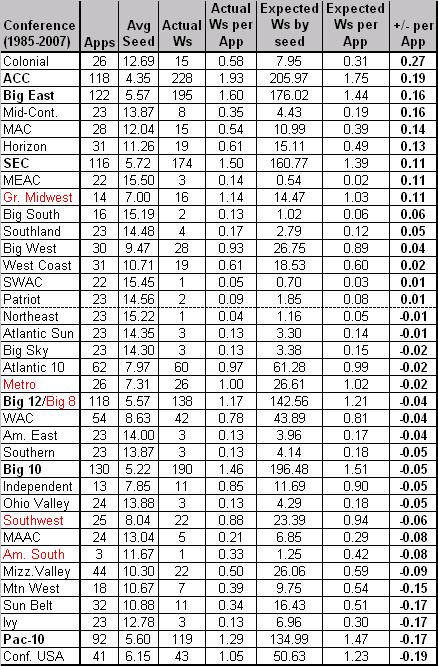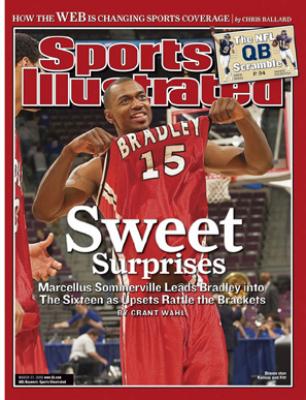Conference Primers: #18 – Summit
Posted by rtmsf on October 30th, 2007
Predicted Order of Finish:
- Oakland (21-8) (15-3)
- Oral Roberts (16-11) (12-6)
- North Dakota St. (16-12) (12-6)
- IUPUI (17-11) (12-6)
- Missouri-Kansas City (14-17) (9-9)
- Southern Utah (13-16) (9-9)
- Centenary (12-17) (8-10)
- IPFW (8-20) (6-12)
- Western Illinois (8-21) (4-14)
- South Dakota St. (5-24) (3-15)

WYN2K. Someone in PR at the Mid-Continent Conference decided that the league needed to be rebranded to effectively portray the goals and ideals of its member institutions. Hence, the Summit, which immediately reminds us of the orange and white monstrosity court at the University of Tennessee, but which league commish Tom Douple stated, represents “the top in athletics and academics.” Good luck with that, Tom. In the spirit of change, the league’s most well-known school (at least for hoops), Valparaiso, left for the Horizon League, while it added three new members – Indiana/Purdue-Fort Wayne (IPFW – shouldn’t it be IUPUFW?), North Dakota St., and South Dakota St. Of the three, only IPFW will be eligible for the league championship this season, as the Dakota schools will have to wait until 2008-09.
Predicted Champion. Oakland (#14 seed NCAA). We see four teams with championship credentials in this league, but Oakland stands out to us as the team most ready to take over the top spot from Oral Roberts. The small school from suburban Detroit (not California) returns three starters from a squad that finished second in both the regular season and tournament, and played ORU very tough in its last two meetings (Oakland won by 1 pt at home, but lost in the MCC championship game by 4 pts). Despite losing all-MCC player Vova Severovas, the Golden Grizzlies will have a superb backcourt led by Eric Kangas, an exceptional shooter who made 109 threes while shooting 43% from deep last year. Oakland is also expecting a big contribution from Rutgers transfer Dan Waterstradt, a 6’10 forward who possesses size and ability that most big men at this level do not have. We also like Oakland in close games – last year it’s ft% (76.9%) was third in the nation.
Others Considered. We’re not sure who will be the second-best team in the Summit, so we copped out and predicted a three-way tie among the next tier of teams – Oral Roberts, North Dakota St., and IUPUI. IUPUI is the media/coaches pick to win the league, with three of its top four scorers returning as well as guard George Hill, the presumptive best player in the league who had a broken foot that kept him out of action last season. Our main concern with IUPUI is whether Hill will be able to seamlessly transition into the backcourt after a productive first season from guards Austin Montgomery and Gary Patterson, the top two vote-getters for newcomer of the year. If things are rosy, IUPUI could make a run at the title. Another team we considered was North Dakota St., an independent last season who ran off twenty wins (20-8) including a win at Marquette (64-60) and near-misses vs. Texas Tech (81-85) and Kansas St. (81-83). NDSU isn’t eligible for the league title, but it returns four starters and seven of its top eight scorers. Wouldn’t it be interesting if they ended up with the league’s regular season crown? We’d be remiss if we didn’t also consider two-time defending league champion Oral Roberts as well. Scott Sutton returns a lot of players, but we can’t overlook the two he lost – Caleb Green and Ken Tutt, who combined for six all-conference selections, three POY awards (all Green), and scored over 4500 pts (!!!) for the program. If ORU’s depth, and there is plenty of that, can overcome the loss of those two stalwarts, we might just see the Golden Eagles in March again this year.
Games to Watch. The Summit will play a true round-robin of 18 games each, so there will be ample opportunity for each team to distinguish itself against the other good teams.
- IUPUI @ Oral Roberts (01.17.08) & Oral Roberts @ IUPUI (02.16.08)
- Oakland @ IUPUI (01.24.08) & IUPUI @ Oakland (02.21.08)
- Oral Roberts @ Oakland (01.12.08) & Oakland @ Oral Roberts (02.07.08)
- The Summit Championship Game (03.11.08) ESPN
RPI Booster Games. The Summit loves its Big 12 and Big 10 teams. Last year the league went 2-22 (.083) against BCS teams, with Oral Roberts pulling one of the biggest early-season shockers of last year (ORU 78, #3 Kansas 71) as well as defeating Seton Hall 76-74. There are some good opportunities this year, and several of them will be televised:
- North Dakota St. @ Florida (11.09.07)
- IUPUI @ Marquette (11.10.07) ESPN FC
- UMKC @ Kansas (11.11.07) ESPN FC
- Oral Roberts @ Texas A&M (11.13.07) ESPNU
- Oakland @ Michigan St. (11.24.07)
- Texas Tech @ Centenary (12.01.07) ESPN FC
- North Dakota St. @ Minnesota (12.03.07)
- Wichita St. @ UMKC (12.15.07)
- Oral Roberts @ Oklahoma St. (12.20.07) ESPN2
- Oregon @ Oakland (12.22.07) ESPNU
Odds of Multiple NCAA Bids. Still none, although we wish they’d let NDSU into the Summit League Tournament just to see what might happen if they won.
Neat-o Stat. By most objective measures, Western Illinois was one of the worst teams in America last year. Its record was 7-23 and its offensive and defensive efficiencies were among the bottom fifty. However, it was also one of the unluckiest teams in America, losing two more games than would be expected by its overall statistical profile and losing eight games by four points or less, the most such instances in the nation.
64/65-Team Era. The history of the league shows that the MCC has had a tendency for one team to dominate for a while before ceding its power to another. From 1987-1990, Southwest Missouri St. won four consecutive NCAA bids. After a few years of several teams winning the league, Valparaiso started its run of seven NCAA bids in nine years in 1996. The last two years Oral Roberts has been winning the bids, with a great shot at a third straight this season. Over the 23-year era, the league has a solid low-major record of 8-23 (.258) in the NCAA Tournament, including two trips to the Sweet 16 (1986 – #14 Cleveland St.; 1998 – #13 Valparaiso). Unfortunately, in the nine years since that Bryce Drew-led run by Valpo, the league has lost its first round game (avg: #15.0 seed) by an average of 21.7 pts (excluding the 2005 PiG, where Oakland, with a 13-19 overall record, defeated Alabama A&M 79-69). Speaking of young Mr. Drew…
Note: video cannot be embedded, so double-click on the YouTube logo above to get it to play.
Final Thought. Notwithstanding the name change, the Summit appears to be a league in transition. Oral Roberts has already shown a commitment toward building a serious program by keeping Scott Sutton on board with a seven-year contract extension. Oakland and IUPUI have also shown signs of long-term progress, and a newcomer like North Dakota St. is well positioned to be competitive in the league immediately. Last year the league earned its highest computer rankings (mid-teens) of the last decade and even with the loss of Valpo, the conference should have enough talent in its top half to keep it among the best of the low majors.












































